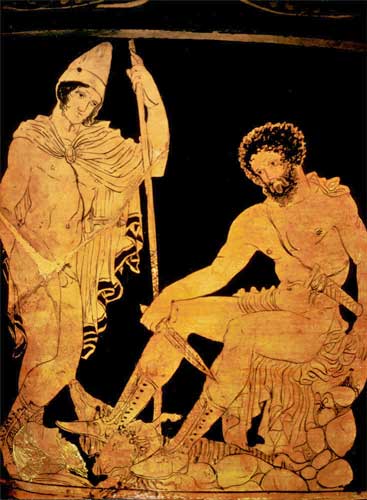

Odysseus and Tiresias in the Underworld. South Italian Red-figure bowl . Detail: Tiresias seated holding sacrificial knife as Odysseus (left) stands by him. Bibliothéque Nationale, Paris. Dolon painter.
In Greek mythology, Tiresias (gr. Τειρησίας) was a blind prophet, the son of the shepherd Everes and the nymph Chariclo. A variant spelling of his name is Teiresias.
Tiresias was a priest of Zeus, and as a young man he encountered two snakes mating and hit them with a stick. He was then transformed into a woman. As a woman, Tiresias became a priestess of Hera, married and had children, including Manto. According to some versions of the tale, Lady Tiresias was a prostitute of great renown. After seven years as a woman, Tiresias again found mating snakes, struck them with her staff, and became a man once more. As a result of his experiences, Zeus and Hera asked him to settle the question of which sex, male or female, experienced more pleasure during intercourse. Zeus claimed it was women; Hera claimed it was men. When Tiresias sided with Zeus, Hera struck him blind. Since Zeus could not undo what she had done, he gave him the gift of prophecy.
Tiresias's background was important, both for his prophecy and his experiences. Greek mythology contained other hermaphroditic figures (including Hermaphroditus), but Tiresias was fully male and then fully female. Also, prophecy was a gift given only to the priests and priestesses. Therefore, Tiresias offered Zeus and Hera evidence and gained the gift of male and female priestly prophecy.
An alternative and less commonly told story has it that Tiresias was blinded by Athena after he stumbled onto her bathing naked. His mother, Chariclo, begged her to undo her curse, but Athena couldn't; she gave him prophecy instead.
As a seer, Tiresias was regarded as inerrant. In Greek literature, Tiresias's pronouncements are always gnomic but never wrong. He is generally extremely reluctant to offer his visions like most Oracles.
During the Seven Against Thebes, Megareus killed himself because Tiresias prophesied that a voluntary death from a Theban would save Thebes.
After the Seven Against Thebes battle, Tiresias appears in the tales associated with Oedipus. In Oedipus Rex, by Sophocles, Oedipus calls upon Tiresias to aid in the investigation of the killing of Laius. Tiresias refuses to give a direct answer and instead hints that the killer is someone Oedipus really does not wish to find. After Oedipus blinds himself and wanders, Tiresias appears in Antigone, also by Sophocles. King Creon of Thebes refuses to allow Polynices to be buried. His sister, Antigone, defies the order and is caught; Creon decrees that she is to be buried alive. The gods express their disapproval of Creon's decision through Tiresias. However, Antigone has already hanged herself rather than be buried alive. When Creon arrives at the tomb where she is to be interred, his son, Haemon, attacks him and then kills himself. When Creon's wife, Eurydice, is informed of their death she, too, takes her own life.
Tiresias died after drinking the water from the spring Tilphussa.
Tiresias' daughter Manto was also gifted with prophecy.
After Tiresias died, he was visited in the underworld by Odysseus, to whom he gave valuable advice concerning the rest of his voyage, specifically concerning the cattle of Apollo, which Odysseus' men did not follow.

Liriope with Narcissus before Tiresias, Giulio Carpioni
Hesiod says that he beheld snakes copulating on Cyllene, and that having wounded them he was turned from a man into a woman, but that on observing the same snakes copulating again, he became a man. Pseudo-Apollodorus, 3.6.7, Library and Epitome.
In post-classical literature
The figure of Tiresias has been much-invoked by fiction writers and poets. Since Tiresias is both the greatest seer of the Classical mythos and a figure cursed by the gods and a man/woman, he has been very useful to authors.
In The Divine Comedy (Inferno, Canto XX), Dante sees Tiresias in the fourth pit of the eighth circle of Hell (the circle is for perpetrators of fraud and the fourth pit being the location for soothsayers or diviners.) He was condemned to walk for eternity with his head twisted toward his back for in life, while he strove to look forward to the future, in Hell he must only look backward. Tiresias' daughter Manto is also assigned her punishment here.
More recently, T. S. Eliot used Tiresias as the primary speaker in his landmark Modernist poem, The Waste Land. Frank Herbert also uses the mythic characteristics of Tiresias in his third Dune novel, Dune Messiah, where the protagonist Paul Atreides loses his sight but has prophetic powers to counter this stemming from insights into both the male and female part of the psyche.
The French composer Francis Poulenc also wrote a lyric piece, using Guillaume Apollinaire's surrealist text Les mamelles de Tirésias (The Breasts of Tiresias).
Oedipus Rex (Pasolini 1967) Tiresias and Oedipus
References
Tiresias appears in the following classical works:
- Oedipus the King, Sophocles
- Oedipus at Colonus, Sophocles
- Antigone, Sophocles
- Bacchants, Euripides
- Iphigenia at Aulis, Euripides
- Phoenician Women, Euripides
- The Odyssey, Homer
- Metamorphoses, Ovid
- Seven Against Thebes, Aeschylus
- Fifth Hymn, Callimachus
See also : Greek Mythology. Paintings, Drawings
Retrieved from "http://en.wikipedia.org/"
All text is available under the terms of the GNU Free Documentation License
| Ancient Greece
Science, Technology , Medicine , Warfare, , Biographies , Life , Cities/Places/Maps , Arts , Literature , Philosophy ,Olympics, Mythology , History , Images Medieval Greece / Byzantine Empire Science, Technology, Arts, , Warfare , Literature, Biographies, Icons, History Modern Greece Cities, Islands, Regions, Fauna/Flora ,Biographies , History , Warfare, Science/Technology, Literature, Music , Arts , Film/Actors , Sport , Fashion --- |

